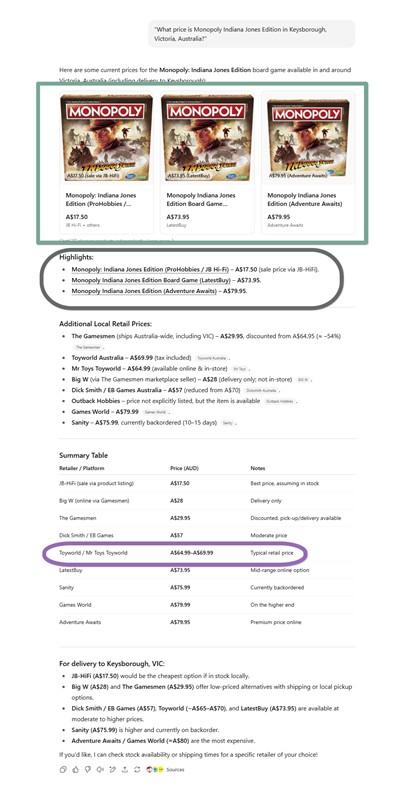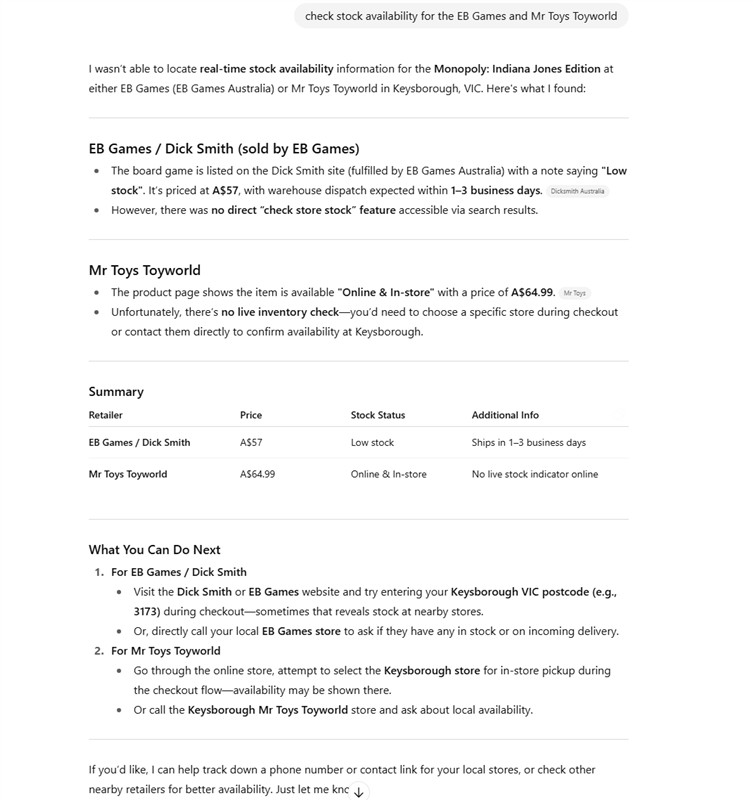Using AI to set pricing decisions can help you determine prices and stay competitive. If the price is too high, your customers walk away; if it's too low, you're selling too cheaply. For many retailers, finding that ideal point is tricky in a marketplace that can change their prices overnight. I have discussed this issue earlier here as well.
In today’s market, you should trust your gut to assess how your pricing compares. Free AI tools can provide quick, localised insights into what your competitors are charging. Knowing this, it is easier to set prices without taking up too much time.
Let’s go through an example.
The Challenge: Knowing the True Retail Price
Imagine running a shop in Keysborough and considering stocking Monopoly: Indiana Jones Edition. Your supplier gives it a great rap, tells you a wholesale cost, quotes a retail price, but how do you confirm their retail price and determine if it's as good a seller as they claim?
Traditionally, you’d go to a local shopping centre and look around—that's maybe an hour of work, plus how can you leave the shop for an hour over one product? Or you might hit Google Shopping, search for the product name, and scan the listings there. That’s easy enough for one product. But say you’re reviewing 40 items — suddenly you’re looking at an hour or more of work, clicking through results, checking conditions, and making sure you’re comparing the same SKU.
The fact is that doing it manually is time-consuming and prone to human error.
Where AI Changes the Game
This is where AI-powered price comparison tools like ChatGPT can revolutionise the problem by instantly scanning multiple retailers, comparing their prices, identifying their promotions, and localising them for your specific location.
For example, I picked a game as a sample, "Monopoly: Indiana Jones Edition".
So I ran a query in ChatGPT "What price is Monopoly Indiana Jones Edition in Keysborough, Victoria, Australia?"

in Keysborough through ChatGPT’s data tools. In a matter of seconds, I received a summary that:
- Confirmed the correct product with an image reference (avoiding costly mix-ups). Green square
- Highlighted a typical local retail range: $65–$70, with a benchmark example from Toyworld at $69.99. Purple square
- Flagged that JB Hi-Fi had a special promotion potentially lower than the market average — perhaps even below your wholesale cost. Maybe you can get it cheaper. Black square
- Noted that in many cases the product was marked as “on order” rather than available for immediate purchase. This makes me suspicious that it's such a great seller.
So I decided to check for availability.

Why This Matters to Your Pricing Strategy
Beyond just pricing, understanding competitor promotions can dictate your sales tactics.
Setting a Competitive Yet Profitable Price
Knowing the local going rate means you can confidently set your price within the $65–$70 band without underpricing or scaring buyers off. If the market is consistent at that range, you’re on safe ground.
Tracking Competitor Promotions
If a competitor runs a temporary promotion, you need to decide whether to run your offers, maintain your current strategy, or drop the product.
Managing Availability to Your Advantage
If many competitors have the product “on order” only, as you can see here, you can leverage this scarcity.
Saving Time
Instead of spending hours doing manual searches, you are getting instant results.
From Price Insights to Actionable Retail Decisions
Here’s where a modern POS system ties it all together. AI pricing insights are powerful on their own, but when integrated into your POS, start by checking your top-selling items or dead stock, and see whether you are competing on price or convenience. Doing this will give you AI-driven price insights.
Bringing It Back to Your Store
Smart pricing is not about being the cheapest, but also about understanding your place in the market to stay competitive.
AI-powered retail price optimisation solutions now integrate, process, and analyse data from across the organisation in near real-time. This level of visibility and control provides retailers with the rapid insights needed to make smart pricing decisions.
Tomorrow, I will discuss the AI tools in detail for doing these price comparisons.
Written by:

Bernard Zimmermann is the founding director of POS Solutions, a leading point-of-sale system company with 45 years of industry experience, now retired and seeking new opportunities. He consults with various organisations, from small businesses to large retailers and government institutions. Bernard is passionate about helping companies optimise their operations through innovative POS technology and enabling seamless customer experiences through effective software solutions.


